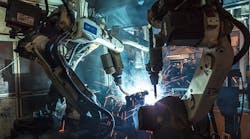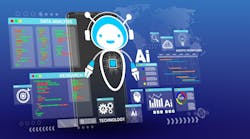BOSTON — Every manufacturer has its own challenges and goals, of course. What works for the shop across town or across the country might not work for you. But why not gather as much information as you can, learn and apply some best practices?
Autodesk recently gathered a couple hundred of its users for a two-day conference in South Boston for its annual Accelerate conference. One of the more informative hours was a panel — The Future of Making Things, of course — of questions and real answers.
Among the panelists:
Arie Henkin, quality assurance manager at Synaptive Medical Inc., a 5-year-old medical device manufacturer headquartered in Toronto
Jennifer Walker, configuration management manager at AmSafe Inc., a Phoenix-headquartered manufacturer of air safety and securement products for the aerospace, defense, and ground transportation industries, and is also dominates the aircraft seatbelt market
Mark Nelson, VP of engineering Fujikura Ltd., which Nelson joked “sounds Japanese because it is Japanese.” Headquartered in Tokyo, the company develops and manufactures power and telecommunication systems products, including devices for optical fibers, such as cutters and splicers
What follows are some of those tech-focused inquiries about the present and, more important, the future.
What is the biggest challenge that you face professionally, and how do you deal with it? And what is the biggest challenge that lies in front of you?
Arie Henkin: “We are a medium-sized company, and we are a medical device company. As a medium-sized company, cost control is definitely a big challenge for us. We need to be able to invest in tools that are flexible and tools that are able to integrate into as many workflows as possible. Being a medical device company, regulations are big. Having a flexible workflow, having integrated workflows, where we’re able to spot objects or carry objects from one workspace to another is extremely important.”
Jennifer Walker: “We have about 95% of the market for aerospace safety belts. Having that much of the market share really presents challenges for growth. We are always trying to find ways to increase productivity, to cut costs, things other than relying on new sales and going to get new customers — though that is a huge part of any business. … We also face a lot of challenges with regulations, we have to comply with all the FAA regulations, and really communicate those regulations throughout the company.”
Mark Nelson: “Our biggest challenge is managing uncertainty. The automotive world is changing pretty quickly right now. We’ve seen new competitors coming from overseas, coming to NAFTA, and the product is changing a lot. We have new car companies from the West Coast that want to disrupt the traditional Detroit Three and some of the Asian transplants. And then you have the autonomous driving and the new powertrains, so the traditional wire-harness business is nearing uncertainty. We try to manage that through just getting the basics right — the right people, the right tools, the right processes — and that’s where PLM helps us tremendously.
“The second part is managing change. OEM customers, if you’re building a vehicle and they find a problem or they want some change like a new product feature, you have to adapt quickly. The third part is just managing the innovation and the new product introduction. We try to do that through making the fundamentals right. A year ago, we didn’t have any wiring on an autonomous vehicle. Now we do. A year ago, we were not making wiring for high-voltage battery packs. Our largest harness was 12 feet long. Now it’s 17 feet long.”
How much do you expect automation to disrupt your process? How much are you seeing in your business right now?
Jennifer Walker: “In our airbag product line, all the bags we made for airbags, they used to be cut manually by a sewing team. The bolts, the straps, everything was sewn manually. Now we have a laser cutter, and that file is managed in PLM. Prior to implementing PLM, there were issues with making sure we had the right file, how to verify it, who could read it. Now we have the controlled traceability on those files that are used to run our machines, and even our sewing machines that are automated have programmable files that are being managed within PLM to ensure that we’re creating a consistent and accurate product. That implementation saved maybe two to three hours per airbag product. … We probably do about a million per year.”
Mark Nelson: “If any of you’ve been to a plant that manufactures automotive wire harnesses, you look out and it’s a sea of people. There’s a statistic that 47% of those jobs that around today are going to be replaced. I believe that’s going to happen with this very labor-intensive manufacturing process. We’re already looking at some machines that will … automate, and drive design criteria. You can’t design a different harness. We’re looking toward the future, and it’s going to be very disruptive to our labor force. We’re going to have to figure out.”
Arie Henkin: “We have a business model of low volume, high complexity, so a lot of what we do is custom and very complex. At this point, our volumes aren’t high enough to employ robotics in the process. Where we are seeing the benefits of automation is in process, in workloads. If I’m able to automatically spawn a corrective action for an audit, that’s one less record, three less buttons that someone has to press. Same thing with data generation: If I can get data out of my manufacturing process, if I can know whether there are any issues coming up, any issues I’m having with performance or in assembly, that’s going to help drive better decision making.”
How are you embracing mass customization? What’s the importance of that in the market, and how are you dealing with it?
Jennifer Walker: “We have a lot of customization in our industry, primarily based around colors, around different leathers. Our airbag products line is prevalent on business jets, so we have these kings from wherever who want their airbags covered in, say, camel hair. We have to figure out how to develop that so it still meets the flammability requirements and other FAA regulations. And they want it right now.”
Mark Nelson: “In the automotive marketplace, every harness is unique. … There are some customers whose harnesses are unique not only to that model and year, but they’ll give us a build sequence, so you have to make that one unique harness that gets sequenced into the vehicle assembly plant. And we make enough harnesses to be in 500,000 vehicles per months. It’s a giant volume of product.”
Arie Henkin: “From a manufacturing standpoint, we’re in the business of mass consistency as opposed to mass customization. We want to make sure that every single medical device that comes out at the end of the line looks the same as the device that came before it and looks the same as the one that comes after it. So there is not a lot of customization for us. … We can do customization within the product, we can tailor a treatment plan to a specific patient, but that’s not a part of the manufacturing process.”




